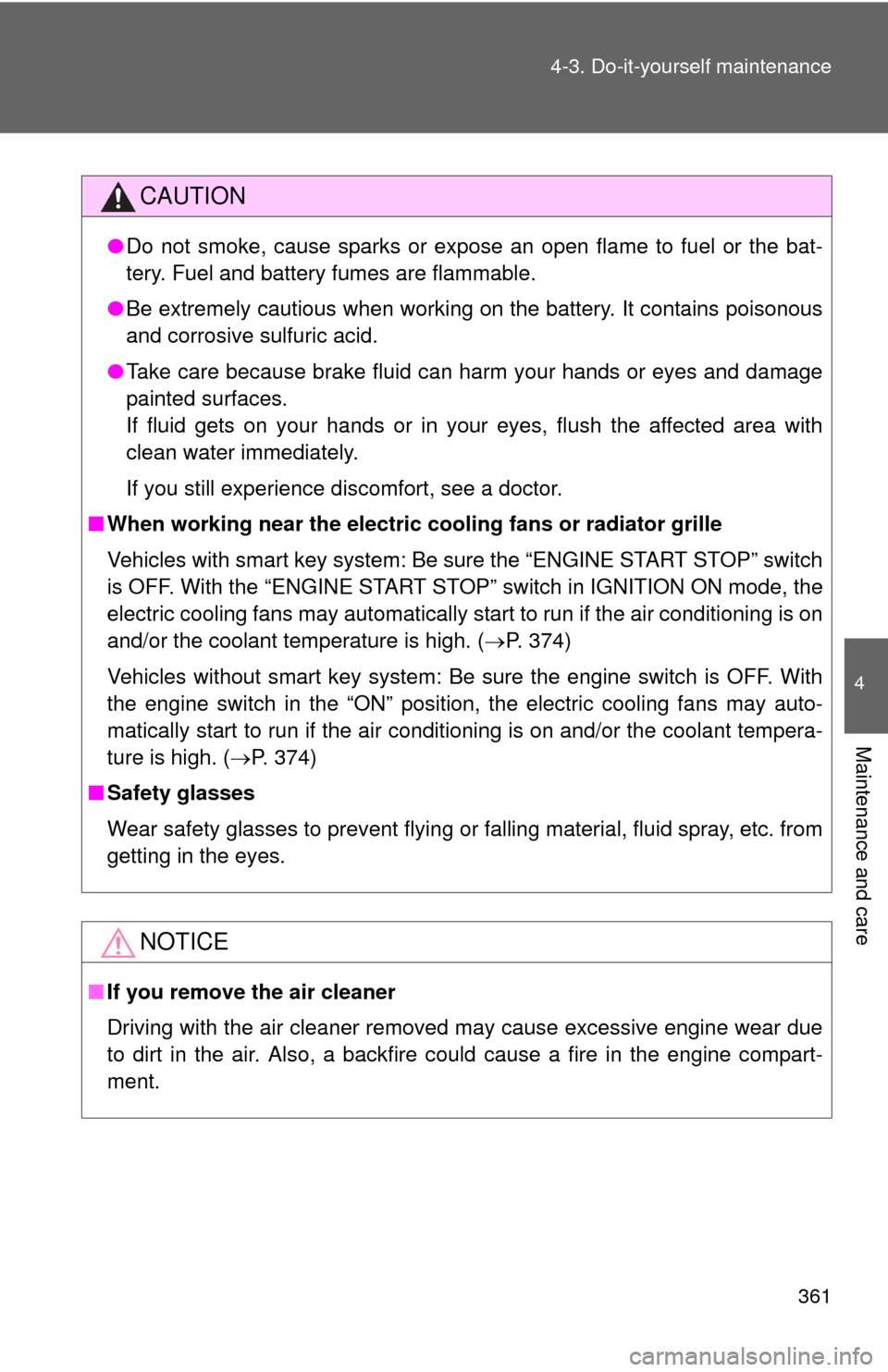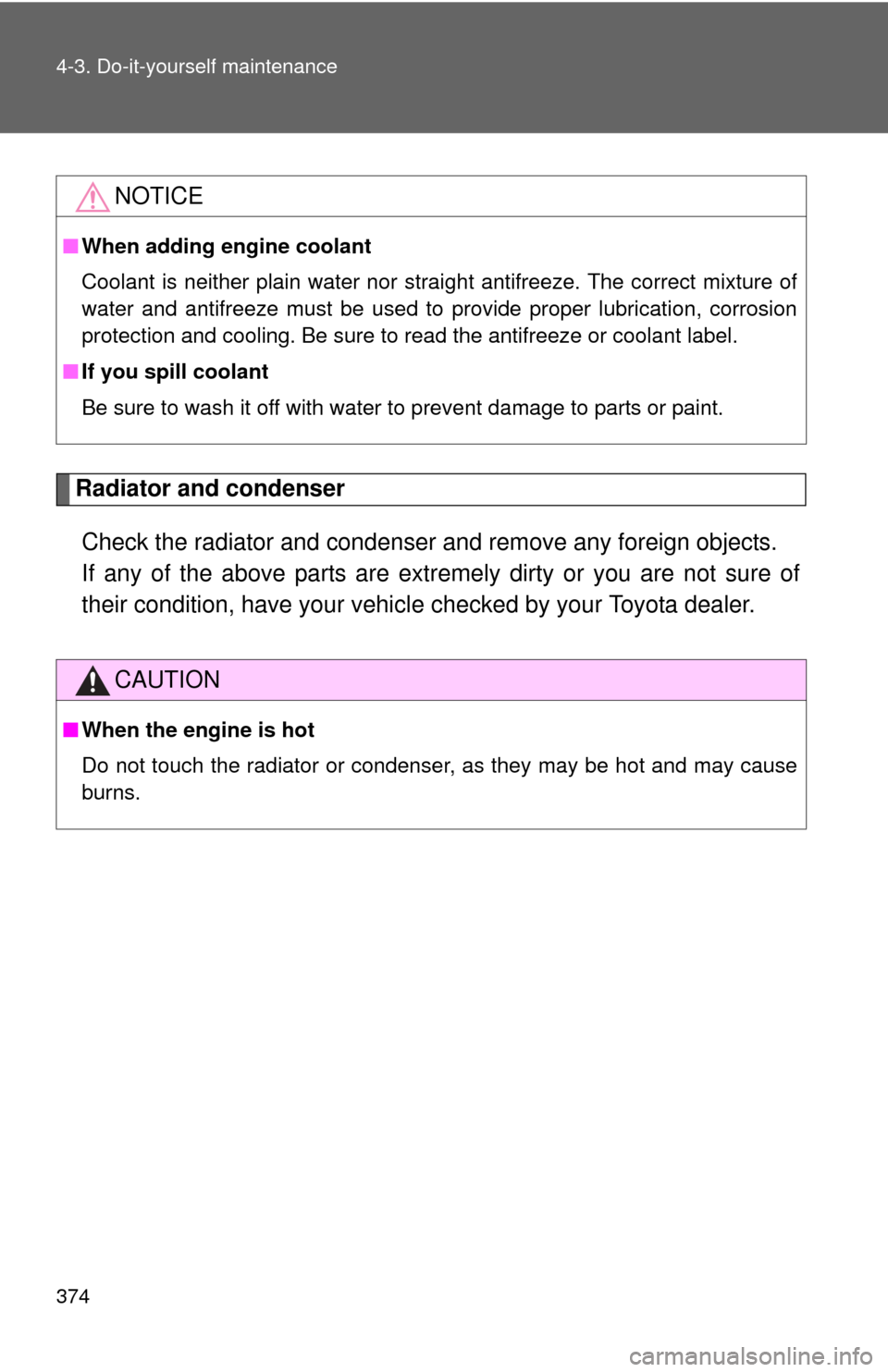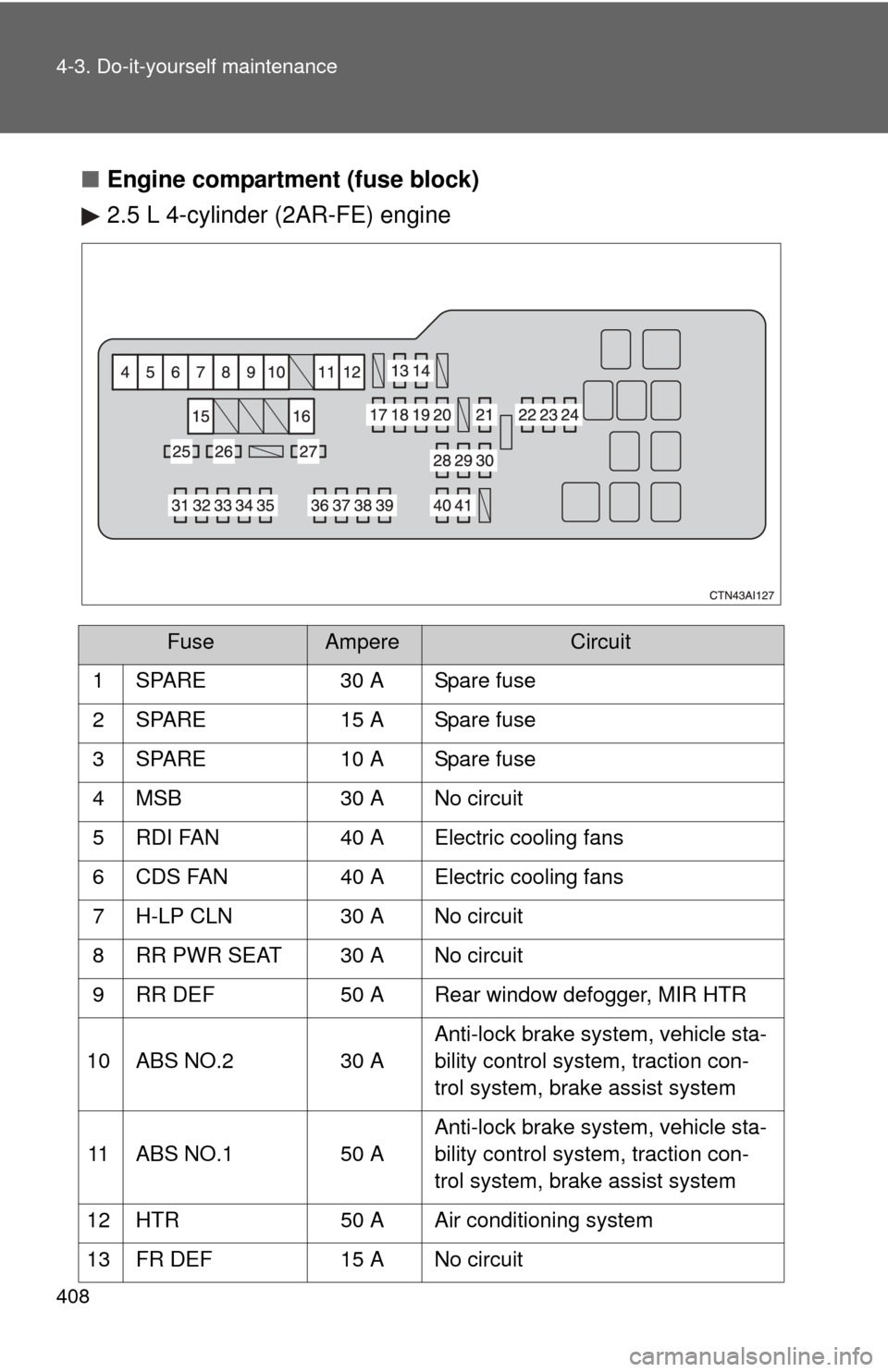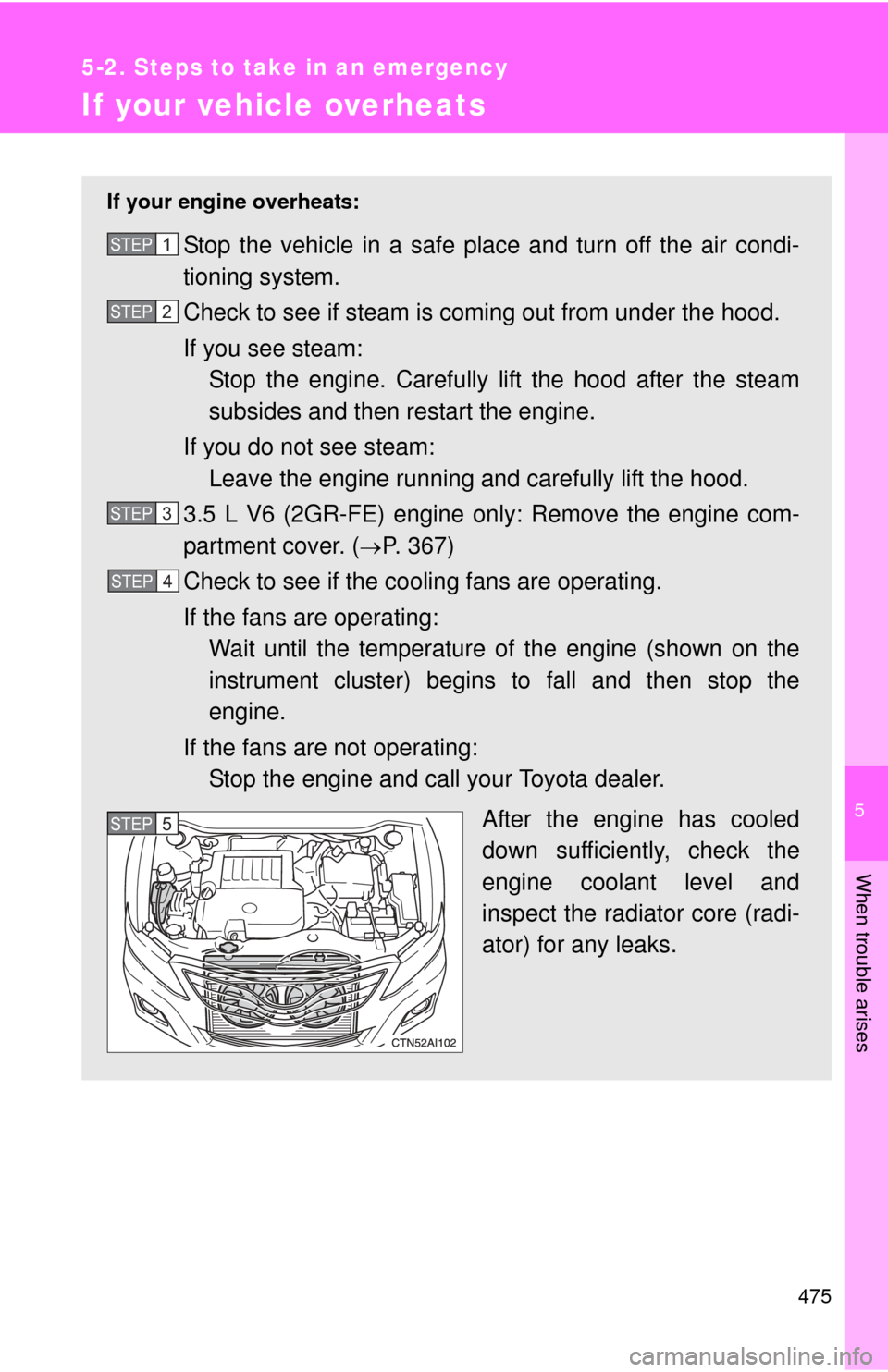cooling TOYOTA CAMRY 2010 XV40 / 8.G Owners Manual
[x] Cancel search | Manufacturer: TOYOTA, Model Year: 2010, Model line: CAMRY, Model: TOYOTA CAMRY 2010 XV40 / 8.GPages: 538, PDF Size: 9.22 MB
Page 205 of 538

205
3-1. Using the air conditioning system and defogger
3
Interior features
Manual air conditioning system
Adjusting the settings■ Adjusting the temperature setting
Turn the temperature control dial clockwise (warm) or counter-
clockwise (cool).
If is not pressed, the system will blow ambient temperature air or
heated air.
For quick cooling, turn the temperature selector knob to the “MAX A/C”
position. The air conditioning will automatically turn on and the air intake
selector will be set to RECIRCULATE.
Fan speed dial Air outlet selection dial
Air intake mode switch Air conditioning on/off switch
Temperature control dial
: If equipped
Page 363 of 538

361
4-3. Do-it-yourself maintenance
4
Maintenance and care
CAUTION
●
Do not smoke, cause sparks or expose an open flame to fuel or the bat-
tery. Fuel and battery fumes are flammable.
● Be extremely cautious when working on the battery. It contains poisonous
and corrosive sulfuric acid.
● Take care because brake fluid can harm your hands or eyes and damage
painted surfaces.
If fluid gets on your hands or in your eyes, flush the affected area with
clean water immediately.
If you still experience discomfort, see a doctor.
■ When working near the electric c ooling fans or radiator grille
Vehicles with smart key system: Be sure the “ENGINE START STOP” switch
is OFF. With the “ENGINE START STOP” switch in IGNITION ON mode, the
electric cooling fans may automatically start to run if the air conditioning is on
and/or the coolant temperature is high. ( P. 374)
Vehicles without smart key system: Be sure the engine switch is OFF. With
the engine switch in the “ON” position, the electric cooling fans may auto-
matically start to run if the air conditioning is on and/or the coolant tempera-
ture is high. ( P. 374)
■ Safety glasses
Wear safety glasses to prevent flying or falling material, fluid spray, etc. from
getting in the eyes.
NOTICE
■If you remove the air cleaner
Driving with the air cleaner removed may cause excessive engine wear due
to dirt in the air. Also, a backfire could cause a fire in the engine compart-
ment.
Page 367 of 538

365
4-3. Do-it-yourself maintenance
4
Maintenance and care
Engine compar tment
2.5 L 4-cylinder (2AR-FE) engine
Power steering fluid
reservoir (P. 376)
Engine oil filler cap ( P. 370)
Engine oil level dipstick ( P. 368)
Brake fluid reservoir ( P. 375)Fuse box ( P. 405)
Battery ( P. 378)
Radiator ( P. 374)
Electric cooling fans
Condenser ( P. 374)
Washer fluid tank ( P. 381)
Engine coolant reservoir ( P. 373)
Page 368 of 538

366 4-3. Do-it-yourself maintenance
3.5 L V6 (2GR-FE) engine
Power steering fluid
reservoir (P. 376)
Engine oil filler cap ( P. 370)
Engine oil level dipstick ( P. 368)
Brake fluid reservoir ( P. 375)Fuse box ( P. 405)
Battery ( P. 378)
Radiator ( P. 374)
Electric cooling fans
Condenser ( P. 374)
Washer fluid tank ( P. 381)
Engine coolant reservoir ( P. 373)
Page 375 of 538

373
4-3. Do-it-yourself maintenance
4
Maintenance and care
Engine coolant
The coolant level is sati sfactory if it is between the “F” and “L” lines on
the reservoir when the engine is cold.
Reservoir cap
FULL
LOW
If the level is on or below the “L”
line, add coolant up to the “F” line.
(P. 475)
■ If the coolant level drops within a short time after replenishing
Visually check the radiator, hoses, engine coolant filler cap, radiator cap,
drain cock and water pump.
If you cannot find a leak, have your Toyota dealer test the cap and check for
leaks in the cooling system.
■ Coolant selection
Only use “Toyota Super Long Life Coolant” or similar high quality ethylene
glycol based non-silicate, non-amine, non-nitrite, and non-borate coolant
with long-life hybrid organic acid technology.
U.S.A.: “Toyota Super Long Life Coolant” is a mixture of 50% coolant and 50% deionized water. (Enabled: -31 F [-35 C])
Canada: “Toyota Super Long Life Coolant” is a mixture of 55% coolant and 45% deionized water. (Enabled: -44 F [-42 C])
For more details about engine coolant, contact your Toyota dealer.
CAUTION
■ When the engine is hot
Do not remove the coolant reservoir cap.
The cooling system may be under pressure and may spray hot coolant if the
cap is removed, causing burns or other injuries.
Page 376 of 538

374 4-3. Do-it-yourself maintenance
Radiator and condenserCheck the radiator and condenser and remove any foreign objects.
If any of the above parts are extr emely dirty or you are not sure of
their condition, have your vehicl e checked by your Toyota dealer.
NOTICE
■When adding engine coolant
Coolant is neither plain water nor stra ight antifreeze. The correct mixture of
water and antifreeze must be used to provide proper lubrication, corrosion
protection and cooling. Be sure to read the antifreeze or coolant label.
■ If you spill coolant
Be sure to wash it off with water to prevent damage to parts or paint.
CAUTION
■When the engine is hot
Do not touch the radiator or condenser, as they may be hot and may cause
burns.
Page 410 of 538

408 4-3. Do-it-yourself maintenance
■Engine compartment (fuse block)
2.5 L 4-cylinder (2AR-FE) engine
FuseAmpereCircuit
1 SPARE 30 A Spare fuse
2 SPARE 15 A Spare fuse
3 SPARE 10 A Spare fuse
4 MSB 30 A No circuit
5 RDI FAN 40 A Electric cooling fans
6 CDS FAN 40 A Electric cooling fans
7 H-LP CLN 30 A No circuit
8 RR PWR SEAT 30 A No circuit
9 RR DEF 50 A Rear window defogger, MIR HTR
10 ABS NO.2 30 A Anti-lock brake system, vehicle sta-
bility control system, traction con-
trol system, brake assist system
11 ABS NO.1 50 A Anti-lock brake system, vehicle sta-
bility control system, traction con-
trol system, brake assist system
12 HTR 50 A Air conditioning system
13 FR DEF 15 A No circuit
Page 413 of 538

411
4-3. Do-it-yourself maintenance
4
Maintenance and care
3.5 L V6 (2GR-FE) engine
FuseAmpereCircuit
1 SPARE 30 A Spare fuse
2 SPARE 15 A Spare fuse
3 SPARE 10 A Spare fuse
4 MSB 30 A No circuit
5 H-LP CLN 30 A No circuit
6 RR PWR SEAT 30 A No circuit
7 RR DEF 50 A Rear window defogger, MIR HTR
8 ABS NO.2 30 A Anti-lock brake system, vehicle sta-
bility control system, traction con-
trol system, brake assist system
9 FAN MAIN 50 A Electric cooling fans
10 ABS NO.1 50 A Anti-lock brake system, vehicle sta-
bility control system, traction con-
trol system, brake assist system
11 HTR 50 A Air conditioning system
12 RR FOG 10 A No circuit
13 ST/AM2 30 A Starting system
Page 476 of 538

474 5-2. Steps to take in an emergency
NOTICE
■To prevent damage to the vehicle ( vehicles with manual transmission)
Do not pull- or push-start the vehicle, because the catalytic converter may
overheat and become a fire hazard.
■ When handling jumper cables
Be careful that the jumper cables do not become tangled in the cooling fans
or any of the belts when connecting or disconnecting them.
Page 477 of 538

5
When trouble arises
475
5-2. Steps to take in an emergency
If your vehicle overheats
If your engine overheats:
Stop the vehicle in a safe place and turn off the air condi-
tioning system.
Check to see if steam is coming out from under the hood.
If you see steam: Stop the engine. Carefully lift the hood after the steam
subsides and then restart the engine.
If you do not see steam: Leave the engine running and carefully lift the hood.
3.5 L V6 (2GR-FE) engine only: Remove the engine com-
partment cover. (
P. 367)
Check to see if the cooling fans are operating.
If the fans are operating: Wait until the temperature of the engine (shown on the
instrument cluster) begins to fall and then stop the
engine.
If the fans are not operating: Stop the engine and call your Toyota dealer.
After the engine has cooled
down sufficiently, check the
engine coolant level and
inspect the radiator core (radi-
ator) for any leaks.
STEP1
STEP2
STEP3
STEP4
STEP5STEP5